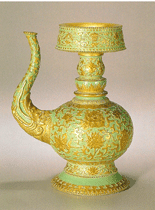REASONS FOR SCROLL FORMAT
• Aesthetic Value: An adequate mounting style contributes to the physical charm of a Chinese painting; in the response to the visual appeal artist invested in the painting, mounting adds style to its visual presentation.
• Storage and Conservation: A high-quality mounting prevents the painting from being damaged by improper handling and display or condition deterioration; its portable nature allows a safe storage; conservation applications can fix physical damage (torn, broken, cracked surface) of a painting with minimal pictorial intervention.
• Economic Consideration: Masterpiece by a famous artist is usually mounted with the materials of the highest quality by the best mounting specialist. A scroll format reserves the physical health of a painting and increases its value in a long term.
REPRODUCTION & FORGERY
Don’t be intimidated by the word of “reproduction” or “fake” when you appraise or collect Chinese painting. Paying attention to the quality of a work and its craftsmanship, you will find surprises at every level that Fine Chinese paintings marked explicitly as reproductions has its own merits.
You can advance your appreciation of classical Chinese painting via the study of reproductions and fakes. By examining the forger’s manner of imitating a master’s brushstrokes, we share the forger’s physically experience of feeling the original creative energy, his interpreted efforts and painting habits or taste. By repeating the original artistic invention, the forger finds inspiration critical to the shaping of a personal style, known as “artistic lineage.”
LEVELS OF APPRECIATION
An appraisal of Chinese art often comments on two levels of appreciation: semi-understanding and full understanding. Art appraisers who partially understand Chinese cultural traditions, grading criteria, and visual aesthetics, and has no Chinese language skills, would focus on the given information (physical attributes and provenance) without verification a work’s individuality in its historical, artistic and commercial contexts. The entry-level appreciation often results in superficial research, depending too much on the third party’s opinions on attribution, dating and value. Art appraisers with professional training in Chinese art history, visual culture and aesthetics, particularly a set of unique language skills often examine the visual representations of Chinese arts from the perspective of an art connoisseur. Appraisals prepared by expert art appraisers emphasize a state of acute sensitivity, an organic process of psychic preparation of having the visual language of a work constantly on one’s mind.
Levels of appreciation reflected in an appraisal report shed light on the signing appraiser’s knowledge of quality, period style, and his ability to recognize the individual features of the attributed master. His knowledge of the complete range of identities (early, later and altered) of a master in question assists his evaluation of the physical resemblance between the questionable and the original, and arriving at the conclusion with a reasonable degree of certainty that the artist might have or couldn’t have painted in such a manner.

